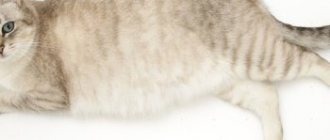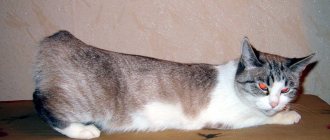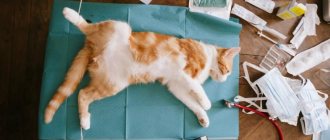Time has passed, and your pet has grown from a mischievous kitten into a kitty that requires attention, and she is in heat. For yard pets during heat, the process of having offspring is much more romantic than for purebred pets, who are deprived of the privilege of choosing an ally. They are forced to live according to the law of their bloodline, they have to be content with who they offered. Sometimes due to these circumstances false matings occur. It seems that a date with a cat has happened, but how can you determine that your favorite will finally bring the long-awaited offspring? In this article we will talk about the main signs of pregnancy in cats.
Signs of successful mating
The most successful period for mating is 3-5 days from the start of estrus. For the process to be successful, the cat must temporarily move in with the cat, and in the first few hours the animals may have misunderstandings and even fights. It is better to give the female time to calm down and get used to the new environment. It is best for the move to take place on the first day of estrus.
Moreover, the cat itself begins to flirt with the cat, provoking him to take active actions, then shows aggression, not letting him near her. Sometimes a cat covers a cat, several times, but the long-awaited success is not observed. In order to figure out whether full coverage has occurred or not, you need to know the signs of successful mating:
- After contact with the cat, the female begins to roll around on the floor.
- The mucous membranes of the genital organs swell and become brighter in color.
- The male completely loses interest in the cat, calmly moves away, and begins to lick himself with enthusiasm.
- If, nevertheless, the cat continues to pay attention to the female, he receives a sharp refusal.
- The cat may lose its appetite and become lethargic within 4 days.
If your cat has a fever and bleeding from the genitals, you should consult a veterinarian.
Appearance and character of the breed
The Thai breed differs from most of its relatives in its well-developed body muscles. Another significant feature is the original coat color: darkened limbs with a uniform light body. Thais also have large blue eyes. The ears and tail are typical and medium in size. The cat's weight ranges from 3.5 to 6 kg.
The existing breed standard specifies a large number of color options. The most popular of them:
- blue point: a blue-gray tone on most of the body combined with a darker gray tone on the paws, tail and ears;
- seal point: a cream-colored body offset by a brown tone on the limbs;
- cake point: stands out with light red shades on a light cream body;
- lilac point: there are pink and lilac shades on the light body;
- tabby: light gray body with darker shades (stripes) of the same color on the limbs.
The Thai breed is very intelligent and quick-witted. Pets easily open small cabinets and handbags, and very quickly guess where the “hands grow” from the rope crawling around the corner. The character of the breed can be described in two words: playful and purposeful. These qualities are inherent in almost all cats, but in Thais they are hypertrophied, which is why the owner will rarely be able to lie quietly all over the sofa. At the same time, cats calmly remain at home alone for many hours and do not throw tantrums about this.
The big advantage of owning a Thai is that (despite its playful nature) the animal does not disturb sleep at night.
The pet finds a common language with other cats and dogs very easily.
Early signs
Not every mating can result in pregnancy. In the early stages, it is quite difficult to find out whether a cat has managed to get pregnant, but you can try to figure it out based on the following signs:
- If after mating the female continues into estrus, then most likely the long-awaited process has not occurred.
- After pregnancy, a cat can be affectionate.
- The animal develops drowsiness, apathy, and decreased appetite. The previously active mischievous woman has turned into a lazy creature - this is how hormonal changes affect her.
- A sharp change in the behavior of the female may indicate hormonal changes in the body.
- In the early stages, a change in the color of the nipples occurs, which turn pinkish. There are times when changes in color do not occur in all nipples, but only in some.
History and legends
The Thai cat was first discovered by travelers in Thailand in the 19th century. At the beginning of the 20th century, the first pets came to England and Germany, from where they began to spread throughout the world. The breed received official recognition only in 1990.
In its homeland, the Thai cat breed is surrounded by a lot of myths. For example, the “Thai” owes his big blue eyes to Buddha, who awarded them to the cat for faithfully guarding the temples.
In ancient times, wealthy families owned Thai cats. The animals were fed from golden dishes, their sleeping places were made from expensive fabrics and materials, hoping that after the death of the owner the pet would intercede for him before the Almighty.
Siamese and Thais should not be confused: despite the fact that the cats are similar in appearance, they are different breeds - the main difference is the denser physique of the latter.
In Thailand, they still believe in the superstition that if you get a Thai cat at home, it will protect your home from evil spirits and bring good luck and fortune.
Late signs of pregnancy detection
More precisely, it is possible to say whether conception has occurred in about three weeks. The following symptoms will help you understand:
- You can use palpation to determine the presence of embryos in the tummy. Pressure must be done very carefully so as not to harm the babies. Too harsh an examination can cause a miscarriage.
- The mammary glands and nipples become swollen and acquire a brighter color.
- There is a sharp increase in appetite, and variability in the perception of foods may occur. Previously consumed food may be rejected, and interest in previously unloved food may appear.
- At 3-5 weeks, the tummy becomes rounded.
- When they reach 6 weeks, the kittens can be palpated.
- At 7-8 weeks, it is possible to notice the movement of the babies, feel the heartbeat, and identify the head and body.
How does this interesting situation unfold?
Caring owners expecting offspring keep special notebooks to monitor how their beloved cat’s pregnancy progresses. You can make a schedule week by week and note all the changes that occur with your cat. This will make it easier to compare the animal’s current health status with the norms. The table shows the optimal course of pregnancy.
Table - Cat pregnancy by week
| A week | Symptoms | Fruit size, cm |
| 3-4 | - Swelling, darkening of the mammary glands; - toxicosis, manifested by nausea, refusal to eat, morning vomiting; - decreased activity | 4 |
| 5-6 | — Increase in body weight; - rounding of the abdomen; - appearance of milk; - sharp increase in appetite | 6 |
| 7-8 | — Shedding; — active nesting; - decreased appetite; - movement of kittens | 9,5 |
| 9-10 | — Decreased activity, apathy; - noticeable enlargement of the mammary glands; - discharge of clear mucus from the vulva; - decrease in body temperature to 37°C | 12,5 |
Just before giving birth, the cat is active. The pet follows its owner, meows, and fusses in the area designated for lambing. The cat's figure becomes pear-shaped: the roundness moves towards the exit of the uterus. There are spasms - contractions. Having noticed these signs, the owner should prepare for childbirth.
Superfetation
During the third to sixth week of pregnancy, a cat may begin to undergo a planned estrus. This happens to one in ten pregnant cats and is considered normal in urban apartments. The body, which receives all the benefits for a happy life (light, warmth, food), “ignores” pregnancy and is ready to mate. This happens due to hormonal imbalance, namely due to a lack of progesterone, which is responsible for bearing offspring.
If your cat often licks her genitals or behaves restlessly, test for the presence of estrus. Apply a tissue to your vulva. If there are transparent spots left on it, the cat has flown.
There is no reason to worry, you just need to protect the expectant mother from potential sexual partners. Otherwise, re-fertilization will occur, which can result in one of three situations:
- miscarriage - both the “older” and “younger” offspring die;
- prematurity - the first kittens are born healthy, the second - premature or dead;
- repeat birth - three to six weeks after the first birth, the cat gives birth again (rarely happens).
The most favorable outcome for a cat is to give birth to healthy kittens from both fathers. However, the mother has a limited number of nipples, and the offspring from the second fertilization may die of starvation.
False pregnancy
It happens that symptoms of pregnancy appear, but the cat does not give birth. This is a false pregnancy. In fact, fertilization has not occurred, but the pet behaves like a future mother. Her shape becomes rounder, her mammary glands swell, and her appetite changes.
The cat begins to build a nest, becomes irritable or, conversely, quiet and calm. An imaginary pregnancy is clearly expressed in the “adoption” of slippers, socks, and mittens. The cat can carry things around the apartment like cubs, and even feed milk.
False pregnancy in cats is not a whim or a game of “mommy”, but a serious mental illness associated with hormonal imbalance. It appears in both mated and chaste pets. Siamese and Persian cats are prone to false pregnancies. Possible causes of hormonal imbalance are:
- stress, emotional shock;
- stimulating ovulation in a castrated cat;
- infectious diseases of the reproductive organs;
- pathologies of the thyroid gland;
- attention deficit;
- proximity to pregnant and lactating cats;
- heredity.
The disorder is treated with a low-calorie diet (milk production decreases) and medications prescribed by a veterinarian. Without treatment of false pregnancy, a cat may develop mastopathy. This is a disease of the pet's mammary glands, which leads to malignant tumors. Also, an imaginary pregnancy, left to chance, will have a bad effect on the psyche, character and behavior of the animal.
To protect your pet from mental and physiological disorders, it is necessary to carry out timely diagnosis of pregnancy. The easiest way to verify the presence of offspring is with an ultrasound, which can be done as early as the third week.
What changes occur before childbirth?
It is very important for the owner to know the due date, because it is unknown how this process will go, and it may be necessary to provide assistance to the pet. You can find out when this period is approaching using the following signs:
- About 3 days before the onset of birth, the cat begins to look for a secluded corner, she looks for a suitable place, and begins to build a nest. To prevent this process from happening on your bed, it is best to prepare for it in advance. You can offer her a box covered with a warm cloth and a sheet on top.
- The cat's nipples sharply increase in size, from which colostrum is secreted. Mucus discharge is observed from the genitals.
- The temperature drops sharply by about 1 degree and can reach 37 degrees.
- 10 hours before the birth of the offspring, the pet hides in its nest. There is no need to disturb her; you can help at this stage by providing fresh water.
Stages
The entire period of gestation is conventionally divided into three periods, they are called trimesters. During these periods, certain metamorphoses occur in the mother’s body and the active development of the fetus. The date of birth of kittens is of great importance.
Premature or post-term offspring may not be viable. Negative is not only being born prematurely, but also after it. Deviations from the norm are allowed for no more than 7 days. In other cases, the likelihood that the kittens will survive is very low.
Each trimester of pregnancy is about 3 weeks.
- First trimester. During the mating process, the egg meets the sperm and acquires a diploid set of chromosomes. After fertilization, the egg is implanted into the uterus. Next, a fetal sac forms around the embryo, and it begins to actively grow and multiply. By day 21, the kitten reaches the size of a small bean, its paws and internal organs are formed.
- Second trimester. During this period, the embryo turns into a fetus, its skeletal muscles and bones, teeth and claws are fully formed. During this period, secondary reproductive organs are formed. The fruits reach a size of 6-8 cm.
- Third trimester. Wool is formed and acquires color. During this period of time, the tail and ears actively increase. Kittens are fully formed at 50-52 days. Further, only an increase in the size of the fruit occurs, without their formation.
Diagnostic definition of pregnancy
Some owners are interested in the question of whether it is possible to determine whether conception has occurred in an animal using a human test. Veterinarians give a clear answer that the test is not suitable for mustaches. It is possible to determine whether the female managed to become pregnant using ultrasound only after the first 2 weeks. After 5 weeks, the veterinarian will perform a palpation test and tell you how many kittens she will give you.
You can find out whether your pet managed to get pregnant using a clinical test for relaxin. This test can provide reliable information only 3 weeks after the expected day of the onset of an interesting situation; it requires blood plasma. The result will be ready in 10 minutes. You can determine whether your attempt to get pregnant was successful using an x-ray 5 weeks after mating.
Purchasing a kitten
It is best to adopt a kitten at 3-4 months: at this age, adaptation to a new home and separation from its mother will occur painlessly. When choosing, it is important to pay attention to the pet’s behavior. It is believed that the animal's high activity and playfulness indicate its good health.
What to pay attention to:
- absence of “whistle” when the animal breathes;
- smooth and clean fur (there should be no wounds or ulcers on the body);
- absence of black spots on the ears, mucus in the corners of the eyes and nose;
- availability of a veterinary passport in which vaccinations will be recorded.
At 12-16 weeks, the kitten should already be accustomed to the tray and scratching post.
When should you contact a veterinarian immediately?
At this time, the cat especially needs a caring attitude from the owner. If she exhibits the following signs, you should call your veterinarian immediately:
- The pet refuses to eat for more than 2 days.
- Fever, above 39 degrees.
- The cat drinks a large amount of fluid and at the same time breathes heavily.
- The female licks herself very often, and dark discharge is observed from the loop. If the discharge is red, you should urgently take it to the clinic.
Attentive attitude to the animal after mating will help to easily determine the presence of pregnancy. Only a specialist will give more accurate information; he will also recommend methods of caring for the cat, tell you how to properly help her prepare for a difficult moment, and give recommendations for helping the animal during childbirth.
How to care for a pregnant cat?
Animals bearing offspring are surrounded with increased attention and affection. They should be fed properly: pregnant pets are given a varied diet containing the required minerals and a complex of vitamins
The latter should not be abused; the use of tablet vitamins is appropriate only if prescribed by a veterinarian
They should be fed properly: pregnant pets are given a varied diet containing the required minerals and a complex of vitamins. The latter should not be abused; the use of tablet vitamins is appropriate only if prescribed by a veterinarian.
It is rational to buy specialized dry food intended for pregnant cats. The content of minerals, amino acids, vitamins, proteins and carbohydrates in it is properly balanced.
If your pet refuses affection and your attention while she is carrying kittens, do not despair. Her body is in a stressful state, if this is the first birth, she herself does not understand well what exactly is happening to her. Do not impose, do not demand anything in return from the animal. Stroke and caress your pet only when he wants it.
In the later stages, try to avoid traumatic situations such as high jumps.
For childbirth, it is better to prepare a warm, secluded place, a box or a small basket, on the bottom of which a soft blanket or terry towel is laid.
It is better to choose a place for this design that is quiet and calm, away from people, but within sight.
Before giving birth, they agree with the veterinarian supervising the cat about obstetric care.
The help of a professional may not be necessary, but as a safety measure, it is better to keep next to you a piece of paper with the numbers of the nearest veterinary clinics or the phone number of the treating veterinarian.











